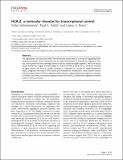H2A.Z: a molecular rheostat for transcriptional control
Author(s)
Subramanian, Vidya; Fields, Paul A.; Boyer, Laurie Ann
DownloadBoyer_H2A.Z.pdf (1.956Mb)
PUBLISHER_CC
Publisher with Creative Commons License
Creative Commons Attribution
Terms of use
Metadata
Show full item recordAbstract
The replacement of nucleosomal H2A with the histone variant H2A.Z is critical for regulating DNA-mediated processes across eukaryotes and for early development of multicellular organisms. How this variant performs these seemingly diverse roles has remained largely enigmatic. Here, we discuss recent mechanistic insights that have begun to reveal how H2A.Z functions as a molecular rheostat for gene control. We focus on specific examples in metazoans as a model for understanding how H2A.Z integrates information from histone post-translational modifications, other histone variants, and transcription factors (TFs) to regulate proper induction of gene expression programs in response to cellular cues. Finally, we propose a general model of how H2A.Z incorporation regulates chromatin states in diverse processes.
Date issued
2015-01Department
Massachusetts Institute of Technology. Department of BiologyJournal
F1000Prime Reports
Publisher
Faculty of 1000, Ltd.
Citation
Subramanian, Vidya, Paul A. Fields, and Laurie A. Boyer. “H2A.Z: a Molecular Rheostat for Transcriptional Control.” F1000Prime Reports 7 (January 5, 2015). © 2015 Faculty of 1000 Ltd
Version: Final published version
ISSN
20517599